






















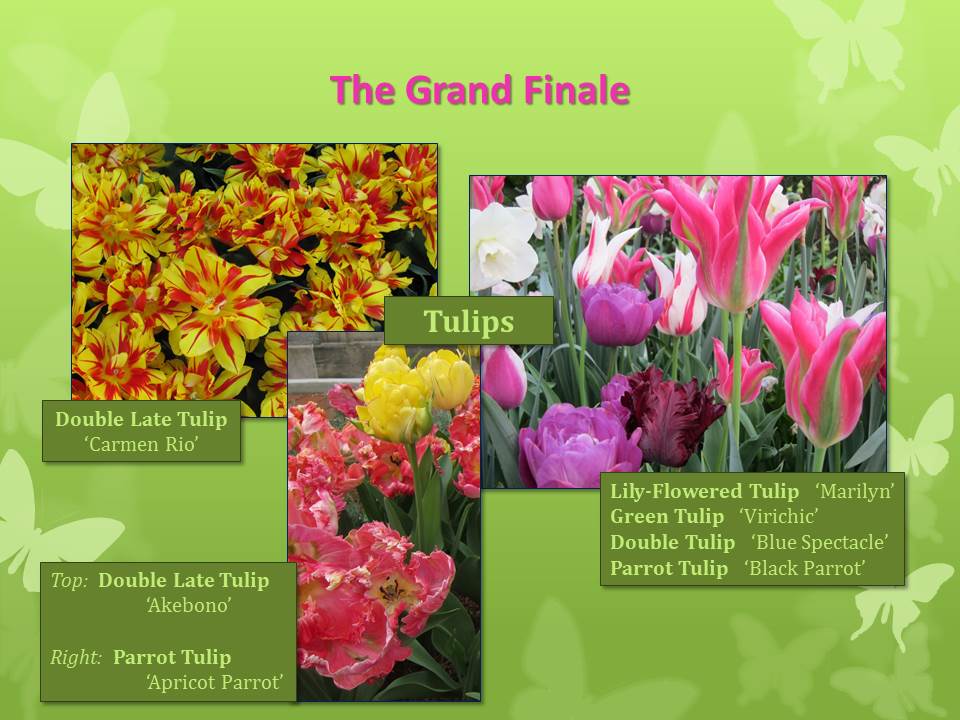

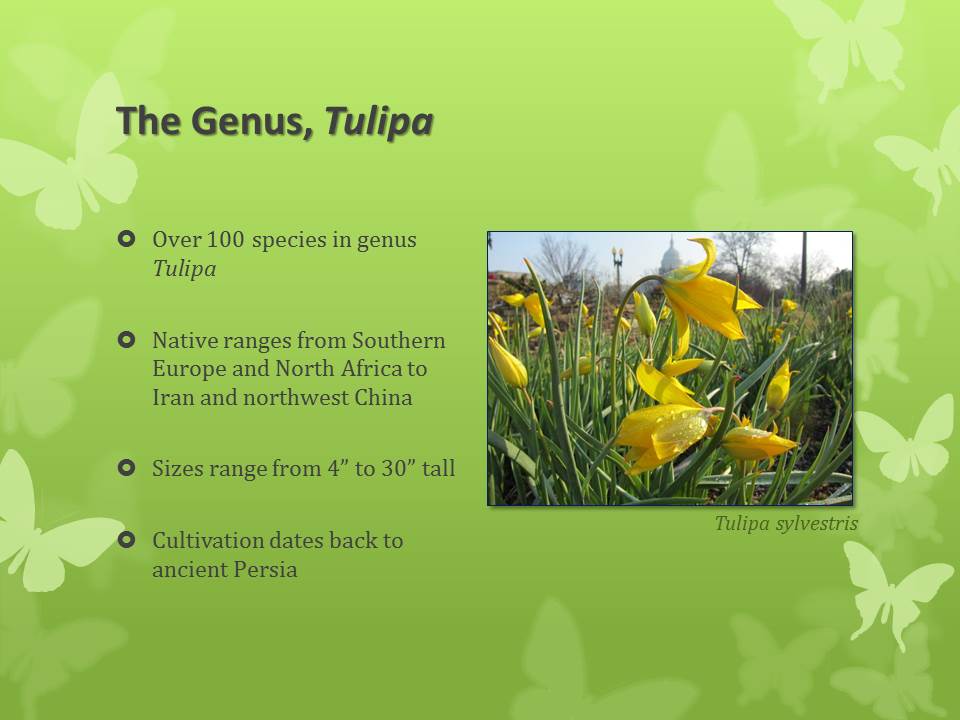
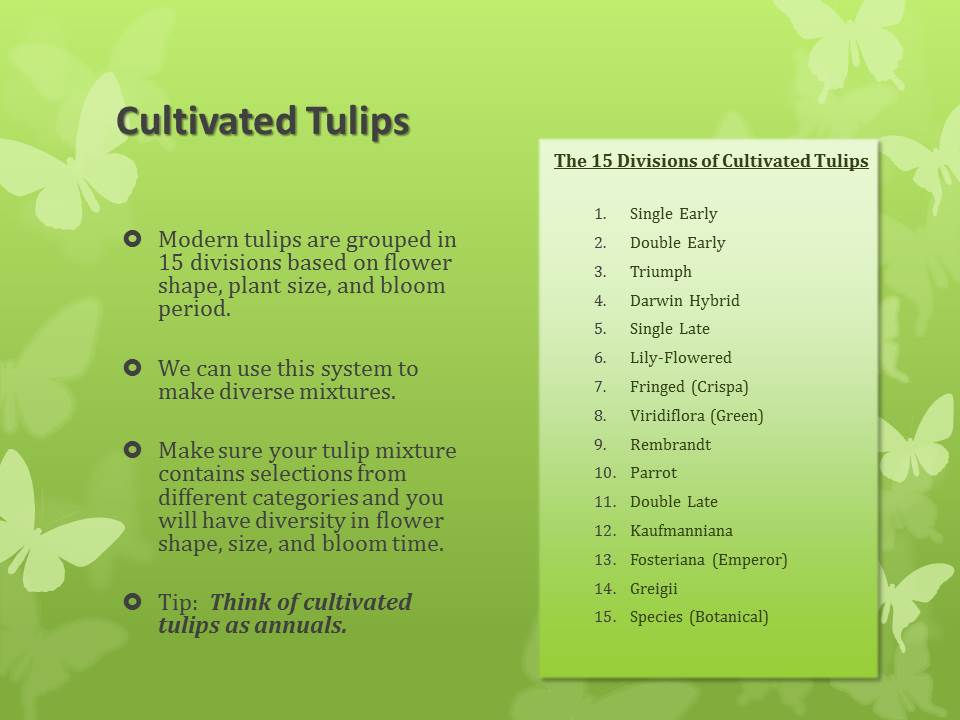
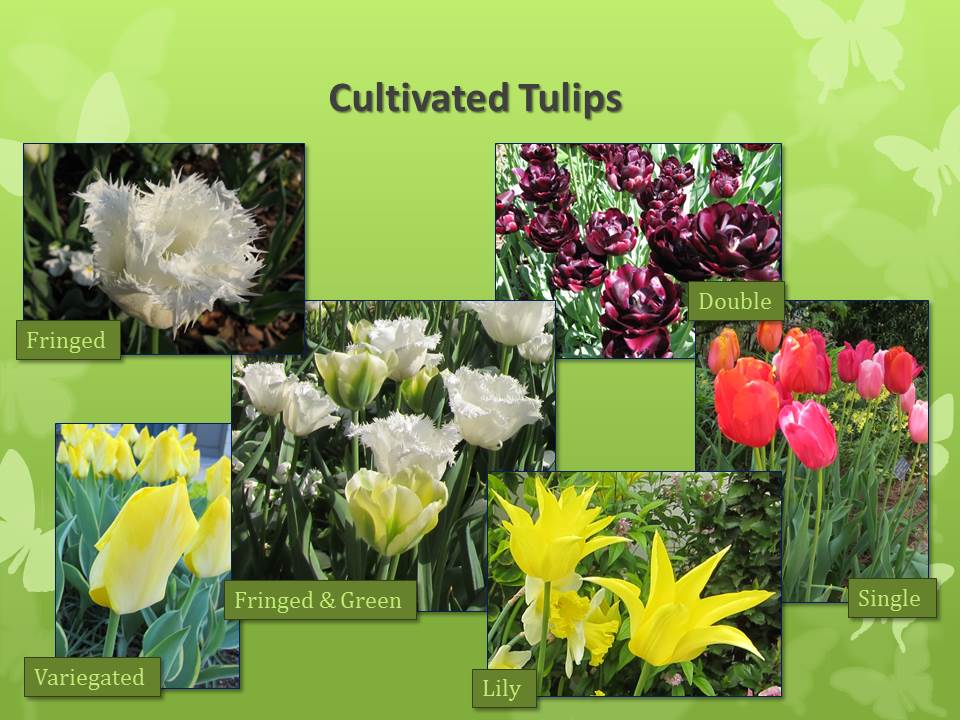
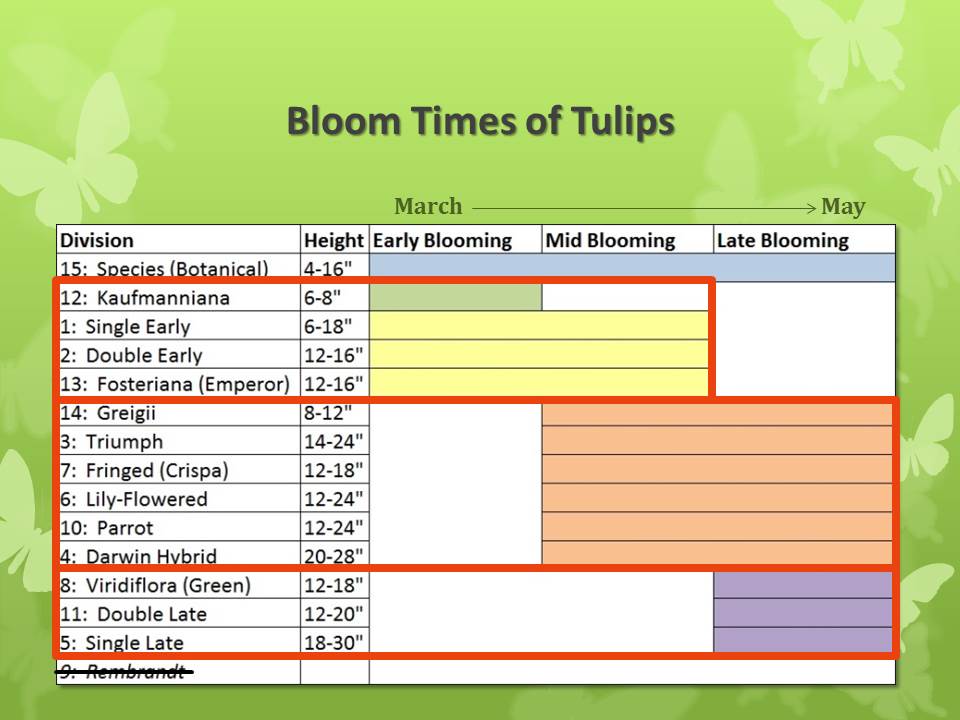
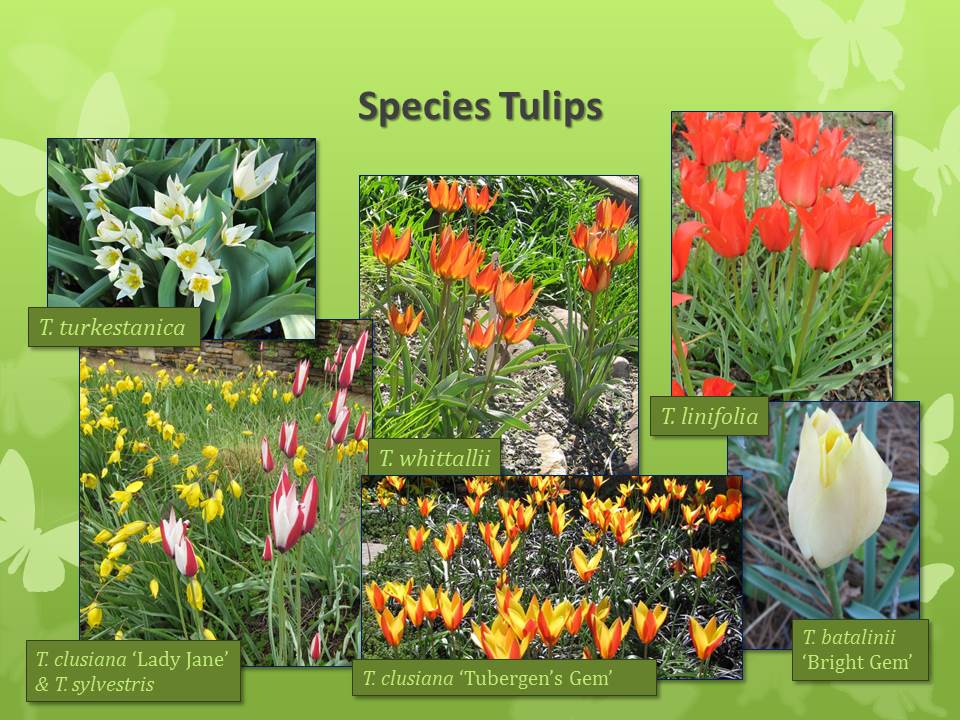
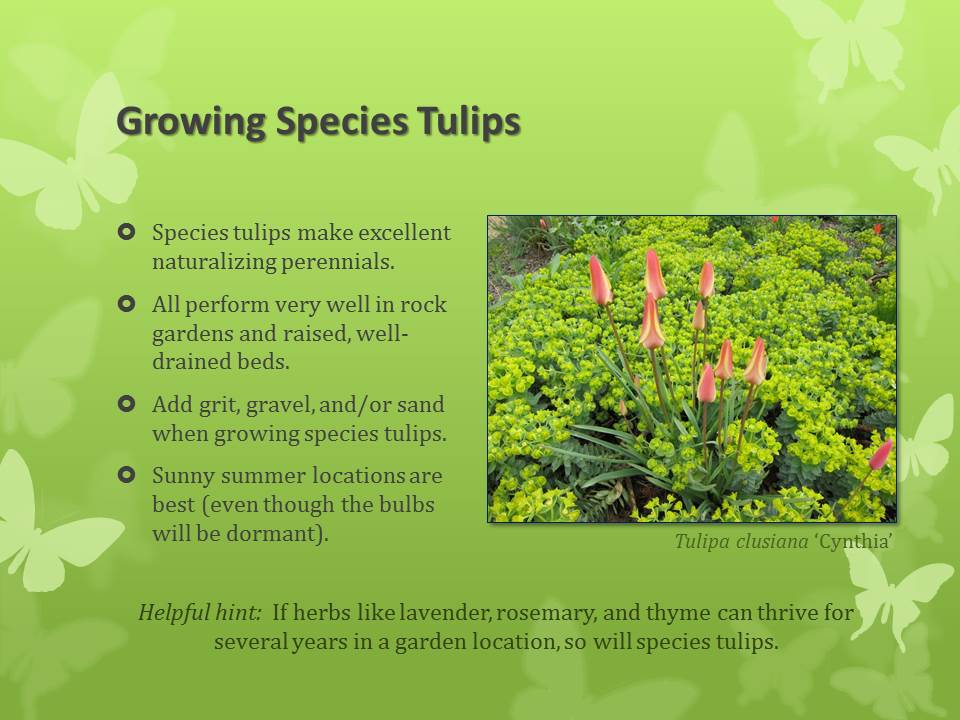
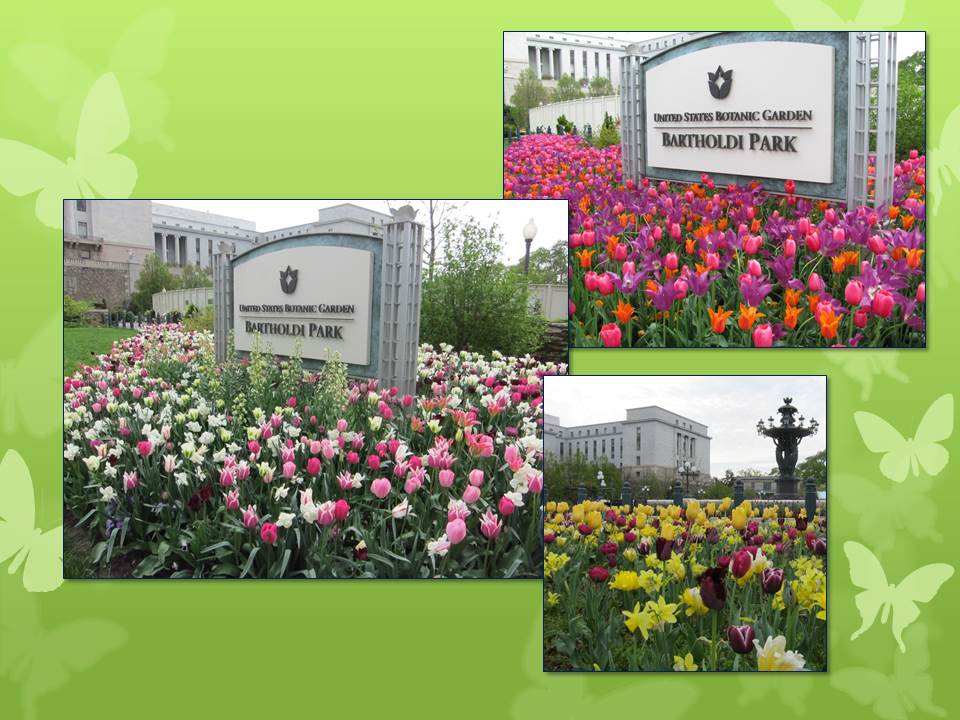

Think Spring: Planning for a “Bloomiferous” Spring Garden
Why plant bulbs?
· Bulbs add color to the garden when it is most needed.
· Bulbs are a sign of renewal and a symbol of rebirth recognized the world over.
· Bulbs can be some of the cheapest, easiest, and most rewarding garden investments.
· Bulbs bring sunshine to the winter-worn soul.
Culture:
Planting Bulbs in the Garden
Site Characteristics:
- Full Sun (during the active spring and early summer growing season)
- Moderate Soil Moisture
- Excellent Drainage
1. Bulbs don’t like wet feet
2. Don’t plant bulbs where the water ponds in the yard or garden
3. Build raised beds or create planting mounds if the drainage is poor
When to plant:
- Bulbs can be planted most any time in the fall up until the time the soil freezes.
- Root growth begins immediately after planting.
- Ideally, plant in October and November when soil temperatures are nearing 55°F.
- A few clues that it’s time to plant your bulbs:
1. You are turning on the heater in your car.
2. The fall foliage colors are starting to show.
3. Asters and mums are past their peak bloom time.
- If you get busy and forget to plant your bulbs, store them somewhere dark, cool, and dry and if they are still firm when the ground is soft enough to work, try planting them out. They aren’t necessarily a lost cause.
How to Plant Bulbs:
- Loose soil makes for easier planting.
1. Use a pitchfork or spade to turn over soil.
2. Use a rototiller for larger planting areas.
- Add organic fertilizers for perennial bulbs (Narcissus, Iris, etc.)
1. Bone meal is an excellent choice for bulbs.
2. Avoid organic fertilizers that tend to retain water.
- Rake soil smooth and mound towards the center of planting area.
- When planting bulbs dig the hole to a depth of about 3 or 4 times the height of the bulb. (Therefore you would plant a 2 inch daffodil bulb in a hole that is 6 inches deep.)
Growing Bulbs in Containers:
- Bulbs make excellent spring container plants and it’s much easier than you thought…
- Step 1: Choose a container.
1. Thicker, heavier materials (concrete, wood, glazed ceramic, etc.) work best as they offer some insulating properties.
2. Avoid metal and plastic pots.
3. Choose a fairly large pot (at least 12” tall and 12” wide). The bigger the better!
- Step 2: Fill the pot halfway with potting soil. Use a bagged soilless mixture and add some grit, gravel, or perlite to improve drainage.
- Step 3: Add bulbs.
1. You can put many, many bulbs in a pot. Don’t worry about recommended spacing as bulbs don’t do well in pots for multiple years. The bulbs can be shoulder-to-should in the pot.
2. You can even plant your bulbs in layers like a wedding cake.
3. Tip: Planting smaller quantities of bulbs in pots can be a great way to experiment with new varieties and get the combination of sizes, bloom times, and colors just right.
- Step 4: Fill remaining space with additional potting soil.
- Step 5: Protect the pot of bulbs.
1. If you live in a colder region or in a very exposed site, protect your potted bulbs. Some options include:
§ Put your bulbs in a non-heated garage during the coldest part of the winter. Don’t keep them in there the whole winter, as they do need some soil moisture to survive and do need to be exposed to cold temperatures during their dormancy period.
§ Place the pot in a porch or next to a warm wall of a heated building.
§ Cover the pot with straw, mulch, or even wrap with bubble wrap to add extra insulation.
Designing with Bulbs
- The most common way that we have experience bulb plantings is in mass plantings.
1. This isn’t necessarily a bad thing as long as you do it right.
2. The advantages of planting large quantities of bulbs in a large open area are:
§ It really makes quite the impact visually.
§ It provides effective color in large scale landscapes.
§ It can make planting easier.
§ It is sometimes more economical to buy bulbs in large quantities.
3. The disadvantages of mass planting are:
§ It can be a bit intellectually and visually boring if you plant 10,000 of one type of tulip.
§ Bulb failures in monocultures mean huge failures in the mass planting.
- Some of my favorite ways of using bulbs include:
1. Planting bulbs in patches or “Splashes”. Plant bulbs in small groupings or drifts that are integrated in the larger garden design, not segregated from it. This way, the bulbs can fill gaps and add color to otherwise dull parts of the garden.
2. Under-planting perennials is another great way to use perennial and naturalizing bulbs in the garden. Bulbs can add effective color to the garden and be happy “bedmates” with some of the later emerging perennials in the garden.
- Don’t plant single bulbs or groups of two or three. Bulbs are most effective in groups of 10 or more. (I recommend working in multiples of 25-50)
- When selecting bulbs to make effective combinations in the garden, choose bulbs with a variety of attributes to make the most of them.
1. Choose a color scheme. Choosing two or three main colors help to create a theme.
2. Choose plants of similar heights so one plant doesn’t dwarf the other.
§ Exceptions: Early-blooming shorter bulbs (daffodils, hyacinths, etc.) can be effective early companions with late-blooming bulbs (i.e. late tulips)
3. Choose plants with different, but overlapping bloom periods. This will ensure an ever-evolving, but long-lasting display.
4. Choose varieties with different flower shapes and patterns.
5. For an added textural dimension, pay some attention to the shape, luster, and color of the leaves.
6. Take advantage of bulbs with patterned, mottled, or variegated leaves.
7. Remember, that if you are planting a perennial combination, that you will want to avoid using cultivated tulips.
Bulb selection: There are many popular bulbs in the trade. Some of the most popular and successful in our region include:
o The late winter/early spring bulbs: these tend to be smaller plants growing between 3 and 12 inches tall, mostly very hard and perennial, and bloom from late January to early March.
§ Snowdrops (Galanthus elwesii, nivalis, etc.)
§ Crocus (Crocus chrysanthus, tommasinianus, vernus, etc.)
§ Dwarf Iris/Rock Garden Iris (Iris reticulata, histrioides, danfordiae)
§ Hyacinths (Hyacinthus orientale), Traditional and Multi-flowering (Roman)
§ Glory of the Snow (Chionodoxa luciliae, forbesii, sardensis)
§ Squills (Scilla siberica, bifolia, mischtschenkoana)
§ Early Daffodils (Narcissus x odorus, ‘Rijnveld’s Early Sensation’, ‘February Gold’)
§ Grecian Windflowers (Anemone blanda)
§
Starflowers
(Ipheion uniflorum)
o The Mid Spring bulbs: these include most of the daffodils, a few of the earlier types of tulips, most Fritillarias, and a few others blooming in March and April.
§ Early and Mid-Tulips (Triumph, Foster, Single Early, Double Early)
§ Trout Lilies (Erythronium revolutum, dens-canis, ‘Pagoda’)
§ Daffodils (Most types except tazetta, poet’s daffodils, etc.)
§ Fritillarias (Fritillaria meleagris – Checker Lily, Fritillaria imperialis – Crown Imperial, Fritillaria persica – Persian Fritillary, and many others)
§
Silver
Bells (Ornithogalum nutans)
o The Late Spring bulbs: these bulbs arguable have the most “gusto” or “bloom power” of the spring-blooming bulbs. They are often large plants with larger flowers in a wide array of very vibrant colors and bloom in April and May.
§ Mid and Late Tulips (Darwin, Emperor, Single Late, Double Late, Parrot, Viridiflora, Fringed, Lily-Flowered, etc.)
§ Late Daffodils (Tazetta, Poet’s)
§ Spanish Bluebells (Hyacinthoides hispanica)
§ Camas (native to western North America, Cammasia quamash, leichtlinii, cusickii)
§ Globe Ornamental Onions (Allium ‘Globemaster’, ‘Firmament’, ‘Ambassador’, etc.)
Tulips:
· The genus Tulipa contains over 100 species and most are native from southern Europe and North Africa to Iran and northwest China.
· Tulips range in size from 4” to 30” tall.
· Cultivation of tulips dates back to ancient Persia.
· Modern tulips are grouped into 15 divisions based on flower shape, plant size and bloom period.
o You can use this system to make diverse mixtures of tulips
o Make sure your tulip mixture contains selections from different categories and you will have diversity in flower shape, size, color, and bloom period ensure a vibrant, interesting, and long lasting display.
o Tip: Think of cultivated tulips as “annuals”, much like you would Impatiens or Marigolds in your spring planting. Although they do often come back the following year, each year more will fail and their blooms will become increasingly less impressive.
· Growing Species Tulips:
o Species tulips make excellent naturalizing perennials.
o All perform well in rock gardens and raised, well-drained beds.
o Add grit, gravel, and/or sand to improve drainage when growing species tulips.
o Sunny summer locations are best (even though the bulbs will be dormant)
o Helpful hint: If herbs like rosemary, lavender, and thyme can thrive for several years in a garden location, so will species tulips.
For More Information about bulbs check out these websites:
1. American Daffodil Society (http://www.daffodilusa.org/)
2. Pacific Bulb Society (http://www.pacificbulbsociety.org/)
3. Brent & Becky’s Bulbs (http://www.brentandbeckysbulbs.com)
4. John Scheepers Beauty from Bulbs (http://www.johnscheepers.com)
5. Colorblends (http://www.colorblends.com)
6. McClure & Zimmerman Bulbs (http://www.mzbulb.com)